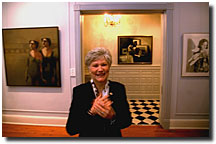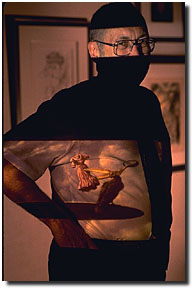
|
|
 ene Van Hove, a radiologist from Carmel, Indiana, recently went to an art gallery in New York to hunt for the perfect Rafal Olbinski painting, but he couldn't find one that really moved him. The gallery owner motioned Gene over to his computer, where he hyperlinked to a Web page with an Olbinski painting that happened to be hanging in a gallery in New Orleans. "The image on the screen looked better than the original, because the lighting was perfect," Gene says. He bought the painting.
ene Van Hove, a radiologist from Carmel, Indiana, recently went to an art gallery in New York to hunt for the perfect Rafal Olbinski painting, but he couldn't find one that really moved him. The gallery owner motioned Gene over to his computer, where he hyperlinked to a Web page with an Olbinski painting that happened to be hanging in a gallery in New Orleans. "The image on the screen looked better than the original, because the lighting was perfect," Gene says. He bought the painting.In this increasingly common type of transaction, customer, dealer, and painting were brought together by an Internet service called ArtView. This private undertaking allows galleries to list -- and show -- one another's inventories. When a customer uses ArtView to select a painting, the dealer ships it to the local gallery, where the buyer has three days to decide whether to make the purchase. Jane Haslem, a gallery owner who runs Artline, a similar Internet service headquartered in Washington, D.C., emphasizes the benefits for the suppliers in her business. "The Internet has opened doors for artists," she says. "While just a few people visit my gallery in person each day, hundreds more visit electronically by linking to Artline." As others marvel at new online galleries, Gene Van Hove wonders why it's taken so long for them to emerge. After all, as a radiologist, he appreciates the potential of computer imaging technology. "This is the future," he says. "It's the best way to shop."
|
|

|
|
|
Jane Haslem, who uses the Internet to extend the range of her Washington, D.C., gallery, appreciates the wider exposure that artists gain by showing works on the Net. (Photograph by Dick Swanson) |
|

|
|
|
Gene Van Hove provides a backdrop for the projected image of a Rafalo Olbinski painting he purchased in New York through ArtView -- from a gallery in New Orleans. (Photograph by Rob Goebel) |
|
|



